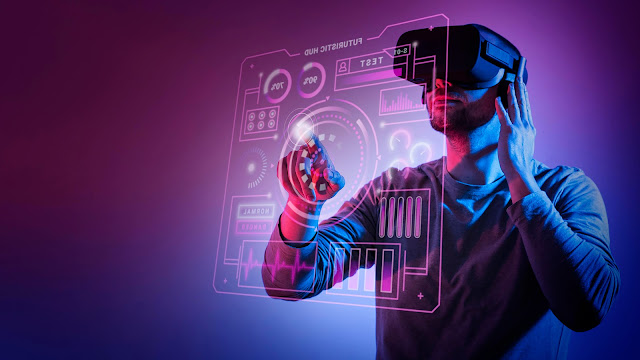Innovation is the key to staying ahead in the ever-changing world of web design. It’s not just about a beautiful homepage. The digital world is changing and your online presence needs to keep up. Whether you are a business owner looking to attract customers or a designer who wants to stay up-to-date with industry trends, today’s web engagement relies on cutting-edge designs that meet today’s user needs.
Did you know that by 2024, there will be more than 8 billion
voice assistants on the planet ready to answer at our command? This has the
potential to revolutionize the way websites are designed and used. Whether
you’re in the market for a professional web
design agency or you’re looking to design your own website, we’ve got you
covered. Read on to find out the expert predictions on web design trends for
2024.
Table of Contents
1. Voice Search & Virtual/Augmented Reality
Voice search is revolutionizing the way we interact online. By 2024, there will be 8.4 billion voice-enabled devices ready to answer to our every voice command. Whether you’re searching for the weather or ordering a pizza, voice recognition is transforming the way we consume information online. That’s why designers are taking advantage of this opportunity to enhance user experiences by integrating voice recognition technology into their products.In contrast, virtual reality and augmented reality (AR) are
revolutionizing the web experience. These technologies provide immersive
storytelling and realistic product previews that transform browsing into an
interactive experience, enhancing user experience. Think of trying on clothes
before making a purchase or visiting a vacation destination as if you were
actually there. VR and AR enable these scenarios to take place right from your
web browser, revolutionizing both learning and e-commerce experiences like
never before.
2. Minimalism in Web Design
The goal of minimalism in web design is to remove the
unnecessary and focus on what matters to the user. This trend emphasizes a
clean look and straightforward navigation paths that result in an improved user
experience. Minimalist websites load faster and eliminate distractions, making
it easier for visitors to navigate. Looking ahead to 2024, the goal of
minimalism is to cut through the noise of the digital world and create a
peaceful online haven where clarity is king. This approach is also in line with
some of the best website conversion rate optimization techniques.
The core of minimalist design is a strong visual language;
it emphasizes recognizable elements that linger in the mind of the user. Brands
benefit from a minimalist approach because it reinforces their identity across
every page of their website. The goal of minimalist design is not just about
less for the sake of aesthetics. It’s about creating user-friendly interfaces
that are easy to use, inviting, and impossible to misinterpret. By keeping
clutter out, you’re putting user comfort first. You’re setting the scene for
visitors to engage with your site without any unnecessary bells and whistles.
3. Amplified Accessibility
Accessibility in web design is now a top priority for
designers. They want to create websites that are easy for everyone to use. They
want to simplify layouts and use clear language. They want their digital
products to serve a wide variety of users, including people with disabilities.
This commitment to inclusion means that more people than ever before will be
able to access and benefit from the internet without any barriers.
In 2024, enhanced accessibility will no longer be just about
meeting standards. It will become a key component of web design significance.
Sites will be able to accommodate different needs with features such as text-to
speech, keyboard navigation alternatives and content that is easy to read by
screen readers. These improvements make the internet a place where diversity of
ability is recognized and celebrated through thoughtful design practices.
4. Artificial Intelligence (AI)
Artificial intelligence (AI) is changing the way web design
works. Websites that use AI and machine learning can create personalized user
experiences that are tailored to each visitor. AI and machine learning enable
websites to analyze data to predict which content will be most engaging and
relevant to users. The result is more user-friendly interfaces, where recommendations
automatically adapt to each visitor’s preferences and browsing habits.
Not only are web designers using AI technologies to improve
user experience, but they’re also using it to automate the design process.
Things like updating databases and resizing images automatically become
automated, freeing up creative minds to focus on more strategic web development
tasks. Chatbots powered by AI are at the top of the list as conversational
tools that provide instant customer support that feels personal and efficient.
This is a win-win situation for businesses looking to stay ahead of the curve
in today’s digital age where web design trends are constantly evolving.
5. Web Security
As cyber threats continue to evolve, web design experts are
emphasizing the integration of advanced security measures. With this in mind,
designers are implementing advanced verification methods, such as biometric
authentication, directly into their platforms to provide users with peace of
mind that their sensitive information will not be compromised.
Blockchain technology has the potential to revolutionize web
security by creating digital records that are immutable, verifiable, and
permanent. Machine learning algorithms are also at the forefront of defense
against cyberattacks, as they can quickly detect and respond to suspicious
activity. All of these innovations signal a shift towards smarter and safer
online environments where privacy and user trust are at the core.
Summary
Are you ready to take the next step? We hope this blog will
help you find new ways to make your website an interesting place to visit.







0 Comments